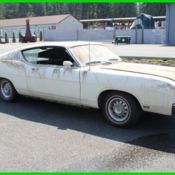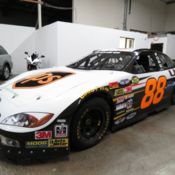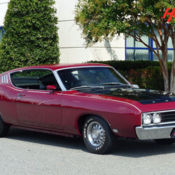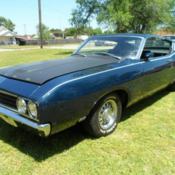1969 Ford Talladega ***1 of 750 Purpose Built For NASCAR Racing***
1969 Ford Torino for sale in Franklin, North Carolina, United States
| Item location: | Franklin, North Carolina, United States |
| Make: | Ford |
| Model: | Torino |
| Trim: | Talladega |
| Year: | 1969 |
| Mileage: | 75,149 |
| VIN: | 9A460200879 |
| Color: | Maroon |
| Transmission: | Automatic |
| Drive type: | RWD |
| Interior color: | Black |
| Vehicle Title: | Clear |
| Want to buy? | Contact seller! |
Description
Up for auction is a very nice example of the Ford Talladega. This car has been lovingly cared for by the previous two owners and has one of the craziest documentation trails you will ever find with a car. The Talladega itself is a rare car with only 750(754 depending on who you ask) made these "Aero Warriors" are even more rare than the Dodge Daytona & the Plymouth Superbird. Below is an exert from Wikipedia describing the cars.The Ford Torino Talladega was a car produced by the Ford Motor Company only during the first few weeks of 1969. Ford's Talladega was named after the Talladega Superspeedway racetrack in Alabama which also made its debut in 1969. The Ford Talladega was a special more aerodynamic version of the Ford Torino / Fairlane Cobra. It was produced specifically to make Ford even more competitive in NASCAR stock car racing and it was sold to the public only because homologation rules required a certain minimum number of cars (500 in 1969) be produced and made available for sale to the public. It is believed that a total of 754 Talladegas may have been built although the Talladega/Spoiler Registry can only account for a maximum of 750. This number includes all prototypes pilot cars and production cars built plus a special post-production car that was built for the president of Ford Motor Company Semon Emil "Bunkie" Knudsen in March 1969. The Bunkie Knudsen car was significantly different from all of the homologation cars with regard to options and color. This Talladega was even built at a different plant: Ford's Lorain OH plant on March 20 1969. However all production examples were constructed during January and February 1969 at Ford's Atlanta Assembly plant in Atlanta Georgia. All production homologation cars produced after the pilot cars were built between January 21 and February 28. (According to the Talladega/Spoiler Registry's records Talladega number 502 was actually completed on January 31 and then the last 247 homologation cars were built between February 14 and February 28 following a 2 week break in production.) It is unknown as to why Ford built an "extra" 247 homologation cars once the homologation requirements had been met during the initial run as it is thought that Ford lost several thousand dollars on every Talladega that was built.The 1969 Ford Talladega was based on the Fairlane Cobra "Sportsroof" (Ford's trade name for a fastback) 2-door hardtop. To make the car more aerodynamic at high speeds a sleeker front section (whose design and construction is often attributed to the Holman-Moody race team's shop) was added. Regular production Fairlanes and Torinos had a then-fashionable inset grille and headlights which fared poorly in the wind tunnel. The Torino Talladega replaced this nose with one that extended the car's length by about six inches with a flush-mounted grille on a more aerodynamic front end. The close-fitting bumper was actually a rear bumper that had been cut narrowed V'ed in the center and filled on the ends to create a crude air dam further improving the aerodynamics of the car at high speeds. In another well kept secret design move the rocker panels of the Talladega were reshaped and rolled to allow Ford teams to run their racing cars about an inch closer to the ground while staying within NASCAR rules; this also greatly enhanced the top speed of the car by lowering its center of gravity and further reducing its wind resistance. The cars were also equipped with an engine oil cooler a power steering oil cooler special offset rear shocks a 3.25:1 Ford 9 inch 31 spline nodular open rear end and most surprisingly: a heavy duty C-6 (cast iron tailshaft) automatic transmission that was column shifted. These other special performance parts were normally only available when ordering a "drag pack car" which would have been equipped with a 4 speed and a limited slip rear end. Also unique to the Talladega was the presence of competition black hoods and rear tail panels on all production cars as well as the only interior offered: black vinyl and cloth with a front bench seat...Racing versions of the car were initially fitted with the Ford FE 427 side oiler engine that had been Ford's main racing engine since 1963. Later in the season the Ford Boss 429 engine was used by many of the teams after it had finally been declared "officially homologated" by NASCAR president Bill France. Ironically the Boss 429 engine was actually homologated in the 1969 Ford Mustang Boss 429. In a very unusual move Ford homologated the engine separately from the car in which it was to race. Many experts think this may have been done in order to get the bodywork of the Talladega officially homologated at the beginning of the 1969 race season as the Boss 429 was not yet in production in sufficient numbers to homologate it. All production Talladegas were actually equipped with the new Ford 428 Cobra Jet which while very powerful and reliable was intended as a street engine for Ford's muscle cars as it developed high torque at low RPMs rather than being a high reving race engine.The only option actually offered on the production vehicles was the color; choices were: Wimbledon White (286 built) Royal Maroon (258 built) or Presidential Blue (199 built). (Note: All production Talladegas are believed to have been built with one additional option - an AM Radio.)The Torino Talladega did exactly what Ford hoped it would do on the racing circuit: it won 29 Grand National races during the 1969 and 1970 NASCAR seasons - far more than any other model. Further it won the 1969 NASCAR Manufacturer's Championship with David Pearson winning the Driver's Championship and it won the 1969 ARCA Manufacturer's Championship with Benny Parsons winning that Driver's Championship. Chrysler's initial competitor was the Dodge Charger 500 which proved to be aerodynamically inferior to the Talladega especially on the highbanks of NASCAR's super speedways (tracks of a mile or more in length). After realizing that Ford's Talladega (and its sister ship the Mercury Spoiler II) were much more effective as race cars Dodge went back to the drawing board to create the Dodge Charger Daytona which managed to win a total of 6 races during the 1969 and 1970 NASCAR seasons. Ironically in 1969 a Dodge Charger Daytona won at Talladega and a Ford Torino Talladega won at Daytona. (At the inaugural race at Talladega in 1969 all of the top names had left on Saturday night before the race due to a strike by the Professional Drivers Association.) Of course having the best talent driving the best cars was also a factor during the aero wars years (1969 and 1970). In an effort to get their star driver Richard Petty back after he had defected to Ford in 1969 Plymouth built the Plymouth Superbird in 1970. (Richard Petty had finished 2nd in NASCAR's Grand Nationals in 1969 driving a Ford Talladega.) Plymouth's Superbird was intended to be more effective competition for the Talladega/Spoiler II and to some extent it was as it matched the Spoiler II's success on the track with 8 NASCAR wins. All of the Superbird's wins came in 1970 which allowed Plymouth to recapture the championship in NASCAR (and in ARCA). (Note: in 1970 NASCAR bumped its homologation requirements which meant that Plymouth had to actually build nearly 2000 Superbirds rather than just 500; thus Plymouth paid very dearly for the Superbird's 8 NASCAR wins in 1970 in order to take the 1970 NASCAR championship.)One other important footnote: 1969 was Ford's last year of factory involvement and/or support in racing of any kind for several years. Following Congressional hearings in which they were questioned about the R&D costs of racing vs. improving fuel economy and safety Ford completely abandoned all of their racing programs starting with the 1970 season. Subsequently most of the NASCAR and ARCA race teams that were running Fords continued to run their 1969 Talladegas in 1970 without any factory support when it became apparent that their Talladegas were aerodynamically superior to the 1970 Torinos that Ford had intended to be the Talladega's replacement. After the 1970 season NASCAR effectively banned the "aero cars" by restricting all five of these limited aero "production" cars to having to compete with engines no larger than 305 cubic inches of displacement (vs. the 426 427 & 429 inches that the other cars could run) and the competitive history of the Talladega (and its fellow aerowarrior rivals) was essentially over.Today a Torino Talladega is a very collectible car. It was a special purpose built vehicle (some have even called it a "showroom race car") with a very strong racing history with major links to the NASCAR teams of 1969 that achieved great success during the Aero Wars. Those few examples that still exist today do so in very limited numbers. Ironically for some reason until recently their values had not risen nearly as high as the Mopar "aero cars" in spite of their rarity and their great track successes during the pinacle of stock car racing (the aero wars years). Some experts have assumed that this was due to the sheer outrageousness of the Dodge Charger Daytona and the Plymouth Superbird with their bolted on huge rear wings and nose cones; as the MOPAR winged cars' prices had eclipsed the far more subtle and aerodynamically integrated bodywork of the Ford Torino Talladega and its sibling the Mercury Cyclone Spoiler II. Regardless most experts still consider the Talladegas and the Spoiler IIs to be very undervalued; but in 1969 (and overall during the two years of the aerowars) Ford's Talladegas (and Spoiler IIs) owned the high banks of NASCAR and ARCA.This car is painted Royal Maroon one of the three color options for the Talladega's. The paint is an older job but shows very nice. There are a few rock chips that have been touched up over the years on the long nose but I'd rate it an 8 out of 10. It shows very well. To the best of my knowledge the car has only had one repaint.The interior is very nice carpet is good seats are good. It has an aftermarket oil and water gauge to keep track of what the 428 Cobra Jet is doing. The only two flaws in the interior that I know of are as follows. There is a small tear in the headliner it will be pictured in the photos. Its actually where the material is came apart at the seam not so much a tear should be an easy fix. The turn signal and shifter handle have a little surface rust on them. These items are easily available aftermarket but we decided to leave them as to not mess with the cars originality. I don't have anyway to prove it but I assume this is probably the original interior in the car. All of the gauges work except the fuel gauge. Probably an easy ground fix but we haven't had it looked at.Under the hood is very nice and original looking. Its a driver so its not perfect but shows very well. The 428 runs awesome fires right up has a nice sound to it. Great oil pressure doesn't run hot. The previous owner stated that he rebuilt the motor several years back. The car is mechanically perfect. We've taken it to many shows within an hour or so including a trip this April of two hours each way to Pigeon Forge to the rod run. I wouldn't be afraid to drive this car to California and back or anywhere I wanted. Its smooth as silk on the road doesn't wander or shake its truly a remarkable driving car for its age. The car shows about 76000 actual miles although the number may go up in fact we are taking it to a show this weekend.As far as I can tell there is zero rust in the car anywhere.What makes this car extremely special is the documention and owner history. We are the third owners of the car. The previous owner had it from 1981 until 2014 the owner before that was the original. There is documentation since the car was new including a mileage log the original owner kept that includes oil levels at each fill up. Every dealer invoice is there when it went in for service I mean everything there is literally an invoice for a turn signal bulb. Original documentation pretty much everything you could want is with the car. It would take an hour to go through it all. I've listed some of the highlights below. There is also a nice photo journal of the car.The car is located in Franklin NC a couple hours from Atlanta Greenville or Charlotte. Feel free to fly in and look at the car before hand. I've described it to the best of my knowledge but one man's idea of good may be another's idea of bad and vice-versa. If you choose to drive the car home there is a rental car company in town you can drop the rental car off at. This car is that good I wouldn't hesitate to send someone across country in it. If you choose to ship it there is a business near by with a parking lot big enough toaccommodatea 18 wheeler with no problems. A $500 dollar non-refundable deposit is due by paypal within 48 hours. Full payment must bereceivedwithin 7 days.Car is AS IS-WHERE IS NOWARRANTYThe car is for sale locally so I reserve the right to end the auction at any time. There are 24 photos in the album above here are a few extras. If you have any questions feel free to call. 828-421-4018.On Jun-07-15 at 17:17:55 PDT seller added the following information:Like I mentioned took it to a show over the weekend. Ended up bringing home Best Ford!! Also had a request for some undercarriage shots I don't have access to a lift right now so I had to do the best I can.
 1969 Torino Talladega Barn Find 428 Cobra Jet NASCAR Champion
1969 Torino Talladega Barn Find 428 Cobra Jet NASCAR Champion
 NASCAR FORD TAURUS BUILT BY ROBERT YATES RACING TEAM UPS 88 CAR
NASCAR FORD TAURUS BUILT BY ROBERT YATES RACING TEAM UPS 88 CAR
 1969 Ford Talladega
1969 Ford Talladega
 1969 Ford Torino Talladega
1969 Ford Torino Talladega
 1969 69 Ford Torino Talladega Fairlane
1969 69 Ford Torino Talladega Fairlane
 1969 Ford Torino Talladega Roller
1969 Ford Torino Talladega Roller
 1969 Ford Talladega, Torino, Fairlane, 428 Cobra Jet, 428cj
1969 Ford Talladega, Torino, Fairlane, 428 Cobra Jet, 428cj